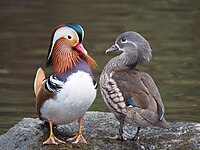
Photo from wikipedia
Individual variation in reproductive ability is a key component of natural selection within populations, driving the evolution of life histories and population responses to changing environmental conditions. Evidence that population… Click to show full abstract
Individual variation in reproductive ability is a key component of natural selection within populations, driving the evolution of life histories and population responses to changing environmental conditions. Evidence that population density affects individual-level fitness in wild populations is limited, particularly for long-lived animals which are difficult to observe on a biologically relevant scales. We tested for individual heterogeneity in reproductive performance in female grey seals (Halichoerus 16 grypus) using 35 years of mark-resighting data at Sable Island, Canada (43.93N 59.91W).We used Bayesian generalized linear mixed-effect models and multi-state open robust design mark-resight models to investigate whether population size negatively influences individual reproductive performance. We measured reproductive performance in two ways: reproductive frequency (the probability of returning to the island to breed) and annual provisioning performance (the probability of successfully weaning a pup given a female bred). Sighting histories of 1655 known-aged females with a total of 22961 pupping events were used for analysis. After accounting for effects of female age, parity, and random year effects, we found that both provisioning performance and reproductive frequency demonstrated a strong, positive correlation with population size. Among-individual variance in reproductive traits and responses to population size indicated considerable heterogeneity in overall reproductive performance. As population size grew, "robust" females increased their reproductive performance more than their more "frail" conspecifics in both reproductive traits, resulting in an amplification of differences among individuals. Consequently, simulations from posterior distributions revealed a large fitness consequence of heterogeneity in this population, with "frail" individuals having 47.1% fewer successful pups than more "robust" females (mean reproductive output ± SD: 9.12 ± 3.77 pups for frail individuals, 16.97 ± 2.94 for robust individuals). Repeatability of overall reproductive performance across environments indicates individual quality may be more influential to lifetime reproductive success than costs associated with reproductive investment. This quantification of relative fitness and its dynamics is crucial to understanding broad evolutionary processes in natural populations.
Journal Title: Ecology
Year Published: 2020
Link to full text (if available)
Share on Social Media: Sign Up to like & get
recommendations!